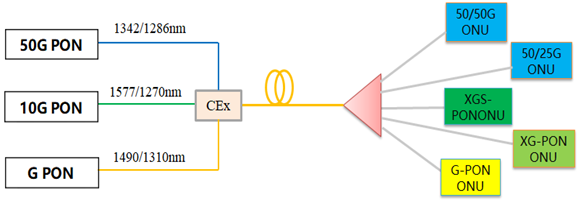Beyond 10Gb/s, the next step will be 50G-PON
October 17, 2022

Sponsored Content
Frank Effenberger
Rapporteur, ITU-T Q2/15 – Optical Systems for Fiber Access Networks
Fellow IEEE, OSA, and Futurewei
One of the most remarkable trends in optical network in recent years has been the rapid replacement of copper access with fiber. The vast majority of these new fiber optic access networks are built using passive optical network (PON) topologies, and to date, more than 700 million subscribers worldwide are enabled by PON-based technologies for high-speed broadband services. Gigabit Passive Optical Network (G-PON) and Ethernet Passive Optical Network (E-PON) dominated early PON deployments to provide hundreds Mbit broadband access services. As users have higher and higher requirements for broadband access speed, in order to provide Gigabit broadband service, network operators have been upgrading to 10G-PON systems in recent years, such as 10 Gigabit-capable Passive Optical Network (XG(S)-PON). By the end of 2021, nearly 10 million 10G-PON OLT ports have been deployed worldwide, providing gigabit network services for tens of millions of users.
Users’ pursuit of higher-speed broadband access service will not stop. After 10G-PON, the International Telecommunication Union ITU-T started to study PON technology beyond 10Gb/s in 2016. After a two-year technical feasibility study period, it was agreed to start a recommendation on Higher Speed PON operating at 50Gb/s line rate in 2018. In September 2021, the first version of the 50G-PON standard was officially published in ITU-T, including technical specifications that support asymmetric rates (50G/12.5G, 50G/25G) and that support two generations of coexistence (coexistence with 10G PON or coexistence with GPON). In September 2022, ITU-T consented the first amendment of the 50G-PON standard (Amd1), which added the technical specifications of the symmetric 50G-PON (50Gb/s in downstream and 50Gb/s in upstream), and that supports the coexistence of three generations (50G-PON, 10G-PON and G-PON coexist at the same time). The wavelength plan that supports this is shown in Figure 1, and the triple coexistence is diagramed in Figure 2.

Figure 1 50G-PON wavelength plan

Figure 2 50G-PON, 10G-PON and GPON triple coexistence
We believe that after 10G-PON, 50G-PON will become the next generation of PON technology. The main reasons are as follows:
1) 50G-PON meets the rhythm and time requirements of PON network evolution:
The compound annual growth rate of global user bandwidth demand is generally around 20%, and the bandwidth demand of users generally doubles every 4 years and 4 to 5 times every 8 to 10 years. According to the experience of the past 15 years, the period for operators to upgrade to the next-generation PON is usually 8~10 years, and 50G-PON can provide 5 times the bandwidth of 10G-PON. Choosing 50G-PON as the next generation is in line with the cadence and bandwidth requirements for PON network evolution. In terms of time line, 50G-PON products are expected to be commercially available around 2024. Before 2024, the existing 10G-PON can fully meet the users’ requirement.
2) 50G-PON is the next generation PON selected by the ITU-T standard
Standardization has always been an important factor for any PON technology to be successfully commercialized, and the ITU-T standard has always led the evolution path for PON industry. For example, the most widely deployed GPON is defined by ITU-T. After years of study and discussion, ITU-T has selected 50Gb/s as the line rate for higher-speed PON beyond 10Gb/s. Although other PONs were also proposed and discussed in ITU-T during this period, such as 25G-PON, 100G-PON, but either because the bandwidth step size was too small or because the technical complexity was too high, they were not finally agreed in ITU-T. Put simply, 50Gb/s PON is currently the only higher-speed PON technology that has been standardized by ITU-T.
3) 50G-PON is the next-generation favored by mainstream operators in the industry
During the defining of the ITU-T higher-speed PON standard, tier-1 operators from North America, Europe and Asia have actively supported and participated in the 50G-PON standard, such as AT&T, Verizon, Orange, Vodafone, China Telecom, China Mobile, China Unicom, NTT and so on. Operators (China Telecom, China Mobile, China Unicom) that have deployed about 70% of the world’s PON networks clearly choose 50G-PON as the next generation. In addition, more and more mainstream operators in the industry support 50G-PON, such as major operators such as Telefonica, Swisscom, Sri Lanka Telecom and Orange have all expressed support for the latest PON standard, indicate they plan to upgrade to 50G PON as soon as possible.
4) 50G-PON is widely supported by the PON industrial supply chain and will be mature and commercialized in the near future
Since the number of PON users is very huge, the diversity of the supply chain is one of the very important factors for the commercial success. Technologies with a robust supply chain are usually more likely to be successful in the market. During the formulation of the 50G-PON standard, it has received wide support from mainstream equipment manufacturers, chip suppliers, and device suppliers around the world. After the release of the 50G-PON standard, a number of mainstream equipment manufacturers have successively released a number of technical prototypes. Furthermore, several component suppliers have begun development of the necessary chips and optoelectronics. With this support, the key technologies of 50G-PON continue to mature, and it is expected to support the commercial use of the technology from 2024.
5) 50G-PON is the most cost-effective solution
Optical access has always been about delivering the best performance for the lowest cost. As outlined above, 50G-PON delivers the necessary increase of bandwidth. The secret to 50G-PONs cost effectiveness is its use of digital signal processing (DSP). With DSP, 50G-PON systems can use 25G-grade components to achieve the required optical loss budgets. In this way, 50G-PON goes twice as fast as a 25G system for the same level of cost. Just as with G-PON versus EPON, the faster system wins out in the end.
About the Author
You May Also Like












_1.jpg?width=300&auto=webp&quality=80&disable=upscale)
